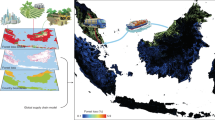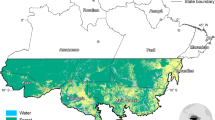Abstract
Global drivers and carbon emissions associated with large-scale land transactions have been poorly investigated. Here we examine major factors behind such transactions (income, agricultural productivity, availability of arable land and water scarcity) and estimate potential carbon emissions under different levels of deforestation. We find that clearing lands transacted between 2000 and 2016 (36.7 Mha) could have emitted ~2.26 GtC, but constraining land clearing to historical deforestation rates would reduce emissions related to large-scale land transactions to ~0.81 GtC.
This is a preview of subscription content, access via your institution
Access options
Access Nature and 54 other Nature Portfolio journals
Get Nature+, our best-value online-access subscription
$29.99 / 30 days
cancel any time
Subscribe to this journal
Receive 12 digital issues and online access to articles
$119.00 per year
only $9.92 per issue
Buy this article
- Purchase on Springer Link
- Instant access to full article PDF
Prices may be subject to local taxes which are calculated during checkout


Similar content being viewed by others
Data availability
This work used data collected from a variety of publicly available sources. See the references in the main text and Supplementary Information for data specification. All figures are based on this collected dataset, and geographically aggregated data (in more refined detail than the source data) will be made available on request to the corresponding author.
Code availability
The R and Google Earth Engine scripts used for the statistical analysis and image processing are available from the corresponding author upon reasonable request.
References
Nolte, K., Chamberlain, W. & Giger, M. International Land Deals for Agriculture. Fresh Insights from the Land Matrix: Analytical Report II (Bern Open Publishing, 2016).
Deininger, K. W. & Byerlee, D. Rising Global Interest in Farmland: Can It Yield Sustainable and Equitable Benefits? (World Bank Publications, 2011).
Davis, K. F., Yu, K., Rulli, M. C., Pichdara, L. & D’Odorico, P. Accelerated deforestation driven by large-scale land acquisitions in Cambodia. Nat. Geosci. 8, 772–775 (2015).
Shete, M., Rutten, M., Schoneveld, G. C. & Zewude, E. Land-use changes by large-scale plantations and their effects on soil organic carbon, micronutrients and bulk density: empirical evidence from Ethiopia. Agric. Hum. Values 33, 689–704 (2016).
Wendimu, M. A., Henningsen, A. & Gibbon, P. Sugarcane outgrowers in Ethiopia: “Forced” to remain poor? World Dev. 83, 84–97 (2016).
Hall, R. et al. Resistance, acquiescence or incorporation? An introduction to land grabbing and political reactions ‘from below’. J. Peasant Stud. 42, 467–488 (2015).
Liao, C., Jung, S., Brown, D. G. & Agrawal, A. Spatial patterns of large-scale land transactions and their potential socio-environmental outcomes in Cambodia, Ethiopia, Liberia, and Peru. Land Degrad. Dev. 31, 1241–1251 (2020).
Johansson, E. L., Fader, M., Seaquist, J. W. & Nicholas, K. A. Green and blue water demand from large-scale land acquisitions in Africa. Proc. Natl Acad. Sci. USA 113, 11471–11476 (2016).
Lay, J. & Nolte, K. Determinants of foreign land acquisitions in low- and middle-income countries. J. Econ. Geogr. https://doi.org/10.1093/jeg/lbx011 (2017).
Ruesch, A. & Gibbs, H. New IPCC Tier-1 Global Biomass Carbon Map for the Year 2000 (Carbon Dioxide Information Analysis Center, Oak Ridge National Laboratory, 2008).
Global Soil Organic Carbon Map (GSOCmap): Technical Report (FAO, 2018).
Le Quéré, C. et al. Global carbon budget 2018. Earth Syst. Sci. Data 10, 2141–2194 (2018).
Hansen, M. C. et al. High-resolution global maps of 21st-century forest cover change. Science 342, 850–853 (2013).
Liu, J. et al. Framing sustainability in a telecoupled world. Ecol. Soc. 18, 26 (2013).
Agrawal, A., Wollenberg, E. & Persha, L. Governing agriculture-forest landscapes to achieve climate change mitigation. Glob. Environ. Change 29, 270–280 (2014).
Lapola, D. M. et al. Pervasive transition of the Brazilian land-use system. Nat. Clim. Change 4, 27–35 (2014).
Rasmussen, L. V. et al. Social-ecological outcomes of agricultural intensification. Nat. Sustain. 1, 275–282 (2018).
Jain, M. et al. How much can sustainable intensification increase yields across South Asia? A systematic review of the evidence. Environ. Res. Lett. 15, 083004 (2020).
Guo, L. B. & Gifford, R. M. Soil carbon stocks and land use change: a meta analysis. Glob. Change Biol. 8, 345–360 (2002).
Acknowledgements
We thank B. Turner (Arizona State University) for fruitful discussions. This research was supported by the National Science Foundation (grant number 1617364), the National Aeronautics and Space Administration (grant number NNX15AD40G), an Arizona State University start-up grant, the German Federal Ministry for Economic Cooperation and Development (BMZ) and a research stipend by the German Academic Exchange Service (DAAD).
Author information
Authors and Affiliations
Contributions
C.L., K.N. and A.A. designed the study. C.L., K.N. and J.A.S. conducted the analysis. C.L. produced the figures. D.G.B., J.L., C.A. and A.A. contributed to data interpretation. C.L., K.N., J.A.S., D.G.B., J.L., C.A. and A.A. wrote the paper.
Corresponding author
Ethics declarations
Competing interests
The authors declare no competing interests.
Additional information
Peer review information Nature Food thanks Thomas Kastner, David Lapola and Floor van der Hilst for their contribution to the peer review of this work.
Publisher’s note Springer Nature remains neutral with regard to jurisdictional claims in published maps and institutional affiliations.
Supplementary information
Supplementary Information
Supplementary Methods, Figs. 1–7, Table 1 and References.
Rights and permissions
About this article
Cite this article
Liao, C., Nolte, K., Sullivan, J.A. et al. Carbon emissions from the global land rush and potential mitigation. Nat Food 2, 15–18 (2021). https://doi.org/10.1038/s43016-020-00215-3
Received:
Accepted:
Published:
Issue Date:
DOI: https://doi.org/10.1038/s43016-020-00215-3
This article is cited by
-
Sustainability governance for agrarian transformation under climate change
Sustainability Science (2024)
-
Carbon emission effect of digital economy development: impact of digital economy development on China’s carbon dioxide emissions
Clean Technologies and Environmental Policy (2024)
-
Influencing mechanism of non-CO2 greenhouse gas emissions and mitigation strategies of livestock sector in developed regions of eastern China: a case study of Jiangsu province
Environmental Science and Pollution Research (2022)
-
Energy implications of the 21st century agrarian transition
Nature Communications (2021)



